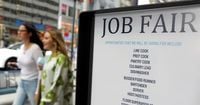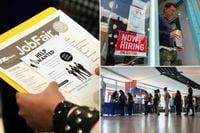The U.S. labor market is sending out mixed signals as autumn sets in, with September 2025 bringing a rare dip in job cuts but an even sharper drop in hiring plans—leaving workers and businesses alike in a state of uncertainty. According to Challenger, Gray & Christmas, a leading outplacement firm, American employers announced 54,064 job cuts last month, marking a dramatic 37 percent decrease from August and 26 percent lower than September 2024. It was only the third time this year that monthly layoffs fell below the previous year’s level, suggesting that the tidal wave of job cuts may be ebbing, at least for now.
Yet, the overall picture is far from rosy. Despite the September reprieve, total layoffs for 2025 have already reached a staggering 946,426—making this the worst year for job cuts since the pandemic chaos of 2020, when more than two million positions vanished. As Andy Challenger, senior vice president at Challenger, Gray & Christmas, put it, “Previous periods with this many job cuts occurred either during recessions or, as was the case in 2005 and 2006, during the first wave of automations that cost jobs in manufacturing and technology.”
But perhaps the most troubling sign is not the layoffs themselves, but what’s happening—or not happening—on the hiring front. Through the first nine months of 2025, U.S. employers planned to add only about 205,000 jobs. That’s a jaw-dropping 58 percent drop from the same period in 2024 and represents the weakest hiring outlook since 2009, when the nation was just clawing its way out of the Great Recession. Challenger described the current environment as a “no-hire, no-fire” labor market, with limited opportunities and relatively few layoffs, but a chilling stagnation all the same.
“Right now, we’re dealing with a stagnating labor market, cost increases, and a transformative new technology,” Challenger said in a statement cited by multiple outlets. He added, “With rate cuts on the way, we may see some stabilizing in the job market in the fourth quarter, but other factors could keep employers planning layoffs or holding off hiring.”
Those “other factors” are weighing heavily on employers’ minds. Economic anxiety is being driven by persistent inflation, ongoing trade tensions, the effects of tariffs, and the disruptive rise of artificial intelligence. According to Challenger, “Tech firms have announced 107,878 layoffs this year due to disruption with AI that is not only costing jobs, but also making it difficult to land positions, particularly for entry-level engineers.” Retail companies and media organizations have also been hit hard, with 86,233 and 14,060 job cuts respectively so far in 2025.
The federal government itself has not been immune. In fact, it’s the top source of layoffs this year, with 299,755 job cuts announced as the Trump administration pursues aggressive workforce reductions. President Trump has warned that more mass firings could be on the horizon if the current government shutdown drags on. The shutdown, which has furloughed some 750,000 federal workers, has now delayed the publication of key economic reports—including the Bureau of Labor Statistics’ all-important September jobs data. As a result, analysts and policymakers have been forced to rely on alternative sources for a picture of the labor market’s health.
One such alternative is a new “real-time” estimate from the Federal Reserve Bank of Chicago, which puts the September unemployment rate at 4.3 percent—unchanged from August and, at least on paper, consistent with what many economists consider full employment. But even here, the details are sobering. The Chicago Fed’s data series, updated twice monthly, showed a slight dip in the hiring rate for unemployed workers and a modest uptick in layoffs and other job separations, putting “limited upward pressure” on the unemployment rate.
Payroll processor ADP added to the sense of caution, reporting that private-sector employers cut 32,000 jobs in September. Even more concerning, ADP’s August estimate was revised from a gain of 54,000 to a loss of 3,000 jobs. “This month’s release further validates what we’ve been seeing in the labor market, that U.S. employers have been cautious with hiring,” ADP chief economist Nela Richardson told the press. Small businesses, in particular, are feeling the pinch: according to technology firm Intuit, firms with one to nine employees shed more than 48,000 jobs in September, continuing a steady decline in employment among the nation’s smallest companies.
With official government data out of reach, the Federal Reserve is watching these alternative indicators closely as it prepares for its next policy meeting. The central bank cut its key interest rate by a quarter point in September—the first reduction since December 2024—bringing the policy rate to a range of 4 percent to 4.25 percent. Traders are betting that another cut is likely at the Fed’s upcoming meeting on October 28-29, with CME FedWatch putting the odds at nearly 99 percent. The hope is that lower rates will help thaw the hiring freeze and inject some life into a labor market that, for now, seems to be treading water.
But the outlook remains clouded by uncertainty. Nonfarm payroll gains averaged just 29,000 jobs per month from June to August 2025, down sharply from 82,000 during the same period last year. Economists point to a perfect storm of factors: tighter immigration policy, trade disputes, and the relentless march of automation and artificial intelligence. These forces have combined to reduce both labor supply and demand, with some sectors hit harder than others.
Should the government shutdown persist, more than just jobs data will be delayed. Reports on consumer prices, retail sales, housing starts, and producer inflation for September may also be postponed, leaving households, investors, and policymakers flying blind at a critical juncture. As Chicago Fed President Austan Goolsbee quipped on Marketplace Radio, “The data dogs are howling because we are not getting our usual supply of information. The best number is the BLS number, but if we don’t have that, we’re going to use the Chicago Fed number and other numbers.”
For now, the U.S. labor market remains in limbo—caught between the relief of fewer layoffs and the anxiety of record-low hiring. As the nation waits for the fog of uncertainty to lift, workers and employers alike are left to wonder: is this a pause before a rebound, or the calm before another storm?






